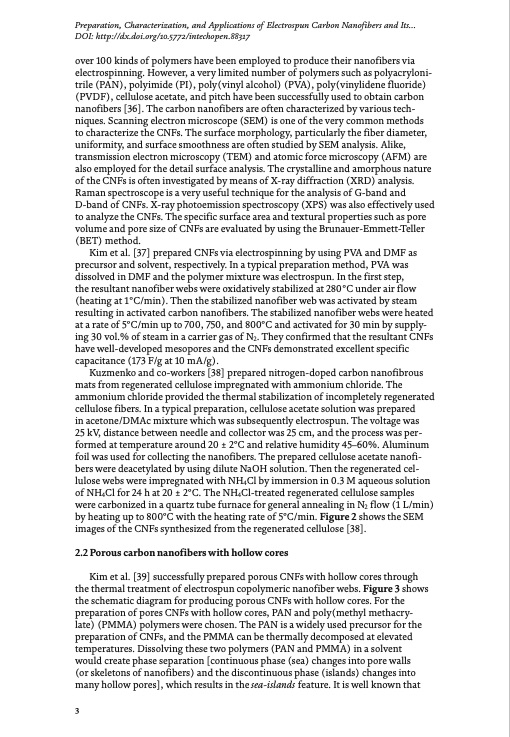
PDF Publication Title:
Text from PDF Page: 003
Preparation, Characterization, and Applications of Electrospun Carbon Nanofibers and Its... DOI: http://dx.doi.org/10.5772/intechopen.88317 over 100 kinds of polymers have been employed to produce their nanofibers via electrospinning. However, a very limited number of polymers such as polyacryloni- trile (PAN), polyimide (PI), poly(vinyl alcohol) (PVA), poly(vinylidene fluoride) (PVDF), cellulose acetate, and pitch have been successfully used to obtain carbon nanofibers [36]. The carbon nanofibers are often characterized by various tech- niques. Scanning electron microscope (SEM) is one of the very common methods to characterize the CNFs. The surface morphology, particularly the fiber diameter, uniformity, and surface smoothness are often studied by SEM analysis. Alike, transmission electron microscopy (TEM) and atomic force microscopy (AFM) are also employed for the detail surface analysis. The crystalline and amorphous nature of the CNFs is often investigated by means of X-ray diffraction (XRD) analysis. Raman spectroscope is a very useful technique for the analysis of G-band and D-band of CNFs. X-ray photoemission spectroscopy (XPS) was also effectively used to analyze the CNFs. The specific surface area and textural properties such as pore volume and pore size of CNFs are evaluated by using the Brunauer-Emmett-Teller (BET) method. Kim et al. [37] prepared CNFs via electrospinning by using PVA and DMF as precursor and solvent, respectively. In a typical preparation method, PVA was dissolved in DMF and the polymer mixture was electrospun. In the first step, the resultant nanofiber webs were oxidatively stabilized at 280°C under air flow (heating at 1°C/min). Then the stabilized nanofiber web was activated by steam resulting in activated carbon nanofibers. The stabilized nanofiber webs were heated at a rate of 5°C/min up to 700, 750, and 800°C and activated for 30 min by supply- ing 30 vol.% of steam in a carrier gas of N2. They confirmed that the resultant CNFs have well-developed mesopores and the CNFs demonstrated excellent specific capacitance (173 F/g at 10 mA/g). Kuzmenko and co-workers [38] prepared nitrogen-doped carbon nanofibrous mats from regenerated cellulose impregnated with ammonium chloride. The ammonium chloride provided the thermal stabilization of incompletely regenerated cellulose fibers. In a typical preparation, cellulose acetate solution was prepared in acetone/DMAc mixture which was subsequently electrospun. The voltage was 25 kV, distance between needle and collector was 25 cm, and the process was per- formed at temperature around 20 ± 2°C and relative humidity 45–60%. Aluminum foil was used for collecting the nanofibers. The prepared cellulose acetate nanofi- bers were deacetylated by using dilute NaOH solution. Then the regenerated cel- lulose webs were impregnated with NH4Cl by immersion in 0.3 M aqueous solution of NH4Cl for 24 h at 20 ± 2°C. The NH4Cl-treated regenerated cellulose samples were carbonized in a quartz tube furnace for general annealing in N2 flow (1 L/min) by heating up to 800°C with the heating rate of 5°C/min. Figure 2 shows the SEM images of the CNFs synthesized from the regenerated cellulose [38]. 2.2 Porous carbon nanofibers with hollow cores Kim et al. [39] successfully prepared porous CNFs with hollow cores through the thermal treatment of electrospun copolymeric nanofiber webs. Figure 3 shows the schematic diagram for producing porous CNFs with hollow cores. For the preparation of pores CNFs with hollow cores, PAN and poly(methyl methacry- late) (PMMA) polymers were chosen. The PAN is a widely used precursor for the preparation of CNFs, and the PMMA can be thermally decomposed at elevated temperatures. Dissolving these two polymers (PAN and PMMA) in a solvent would create phase separation [continuous phase (sea) changes into pore walls (or skeletons of nanofibers) and the discontinuous phase (islands) changes into many hollow pores], which results in the sea-islands feature. It is well known that 3PDF Image | Preparation, Characterization, and Applications of Electrospun Carbon Nanofibers

PDF Search Title:
Preparation, Characterization, and Applications of Electrospun Carbon NanofibersOriginal File Name Searched:
68337.pdfDIY PDF Search: Google It | Yahoo | Bing
Sulfur Deposition on Carbon Nanofibers using Supercritical CO2 Sulfur Deposition on Carbon Nanofibers using Supercritical CO2. Gamma sulfur also known as mother of pearl sulfur and nacreous sulfur... More Info
CO2 Organic Rankine Cycle Experimenter Platform The supercritical CO2 phase change system is both a heat pump and organic rankine cycle which can be used for those purposes and as a supercritical extractor for advanced subcritical and supercritical extraction technology. Uses include producing nanoparticles, precious metal CO2 extraction, lithium battery recycling, and other applications... More Info
| CONTACT TEL: 608-238-6001 Email: greg@infinityturbine.com | RSS | AMP |